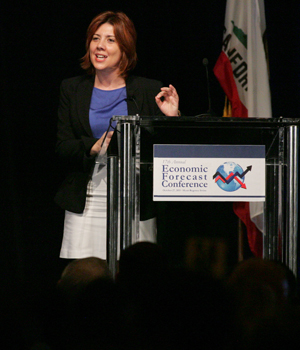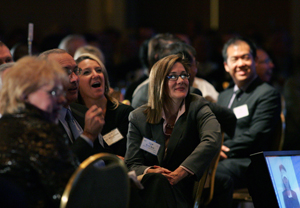Where’s My Boom?
Economists Say Full Recovery Will Be Long in Coming
Anil Puri used baseball great Yogi Berra's famous phrase “It ain’t over ’til it’s over” to kick off his annual economic forecast Oct. 27 before an audience of more than 800 business, community and university leaders.
 Caption: Anil Puri addressed Orange County employment trends during his Oct. 27 economic forecast before an audience of more than 800 business and community members. Photo by Karen Tapia Download Photo
Caption: Anil Puri addressed Orange County employment trends during his Oct. 27 economic forecast before an audience of more than 800 business and community members. Photo by Karen Tapia Download Photo
Growth in jobs, housing and real GDP that had begun in late 2010 and earlier this year has since stalled, explained the dean of CSUF’s Mihaylo College of Business and Economics. “And I don't have to talk to you about the stock market ....”
The stall, he explained, came from not only the temporary factors of the Middle East turmoil and its effect on oil prices, and Japan's earthquake and tsunami that disrupted supply chains around the world, but “more fundamental issues”: the debt ceiling talks, GDP revisions, the Eurozone crisis and waning fiscal support.
On the positive side, he said, the country should be able to avoid another recession but full recovery will continue to be a slow, shallow “slog.”
Puri noted that there is no one main driver in the road forward, and that small gains in a number of sectors — including corporate profits, exports, business investments and some job growth — are needed. Drags on the recovery will continue to be housing, income, state and local government deficits and persistent unemployment.
Bringing a touch of humor to the forecast, Mira Farka, associate professor of economics, dubbed the economy “Humpty Dumpty” and said “I’m leaving the door open for putting the economy together again.”
The problem, she noted, is that throughout the last decade the job growth has been half of what it was in the previous three decades, and previous recoveries have become more and more “jobless” so that it has taken longer to reach prerecession employment levels.
During the latest recession, the economy lost 6.7 million jobs, she noted. Less labor mobility and the extension of unemployment benefits have both added to the unemployment rate.
“We will need to add 21.5 million jobs in this decade to make up to reach the ‘magic 5 percent’ unemployment rate,” Farka said, adding that how quickly we recover will depend on “how many jobs per month we can grow.
“If we create only 125,000 jobs per month, we will just keep up with population growth and never get to 5 percent,” she said. If the economy grows 200,000 jobs per month, we will be “back to normal” by early 2019; if it’s 250,000, by late 2016, and if the economy creates 400,000 per month, the country will reach the level of 5 percent unemployment by mid-2014, she said.
Other issues, she discussed: consumer spending, bringing down household debt and the cost of housing, the outlook for the global economy and trade and fiscal policy.
“Fiscal policy can single-handedly turn things around, but only if done right and only if it is simultaneously accompanied by tough long-term credible plans for an orderly unwinding of the massive amounts of government debt,” said Farka.
Ideally, the plan would maintain short-term stimulus while addressing long-term budgetary issues, she said, including entitlement reform and tax reform.
“We have to figure out new rules of the game,” said Puri. “Don’t expect miracles. Despite that, we believe we will continue to recover — even if it is very slowly.”
Oct. 27, 2011



